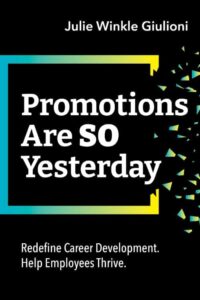Promotions are So Yesterday
Continuing instability within the workforce (the Great Resignation that we hear about daily) has re-ignited the war for talent. Organizations and leaders everywhere are challenging themselves to find ways to engage and retain employees. Julie Winkle Giulioni offers a framework for doing just this in her new book, Promotions Are So Yesterday. I recently had a chance to connect with Julie and explore why – and how – we can redefine career development and help employees thrive.
Why are promotions ‘so yesterday’?
In the past, organizations were flush with hierarchical layers. Employees remained in companies for years and even decades. Workers retired at an earlier age. And ambitious people had the opportunity to regularly climb the rungs of the corporate ladder.
But the world is different today. Organizations are flatter. Openings frequently go unfilled. Tenures are shorter. And – at least until recently – baby boomers were working longer.
In addition, recent events have caused many employees to re-think their relationship with work. They’re willing to trade the titles and positions for greater meaning, balance, flexibility, opportunities to learn, the ability to make a difference, and novel challenges and experiences.
The artificial yardstick used in the past to mark and measure careers is giving way to more organic, personal ways of evaluating success.
And all of this makes promotions so yesterday – at least as a default mindset.
What’s changed in career development over the course of your own career?
So much! Career development used to be linear. It was all about that upward progression. Lateral – or God forbid downward – moves frequently reflected poorly upon ambitious professionals. I remember the advice (and admonishments) I received when I decided to leave my university department chair/professor role to take a ‘lower level’ position in industry. It just typically wasn’t done.
Now, career development is much squigglier (to use authors Helen Tupper’s and Sarah Ellis’s term.) People can move up, down and all around. They can go away and return – not something that was typical in the past. Upon tendering my resignation back in the ‘80s, I was summoned to the office of the vice president (a former IBM HR VP) and informed that if I left, I’d “never be welcome back.” This is certainly a far-cry from the warm handshakes, alumni groups and re-hiring strategies implemented by many organizations today
Finally, contemporary career development operates outside of the walls and boundaries imposed by organizations in the past. People can grow their careers through gig assignments – both inside the company and outside. The rise in entrepreneurship offers tremendous opportunities to cultivate new skills and experiences that enhance one’s portfolio and career. Volunteerism allows for challenges and learning that people can apply to their work and career aspirations.
Beyond, between and besides the upward climb, there are countless ways people want to grow even more than promotions.
The opportunities and avenues are so much more plentiful today – and this means that people can develop the careers they want – the way they want to.
What is the climb culture and what is shifting in this regard?
The climb culture refers to the traditional ‘onward and upward’ mentality – the idea that careers develop in one direction according to the organization’s roadmap. Employees can no longer expect – and many no longer want – to be tapped on the shoulder every 18 months and invited up one more rung on the hierarchical ladder.
Careers are more organic today. Many organizations need greater breadth of expertise and are encouraging employees to branch out, experiment within different functions, become generalists rather than specialists. All of this opens new – and more – opportunities for people to grow, become engaged, and thrive at work.
Tell us a little about the Multidimensional Career Self-Assessment that’s at the heart of your new book. How can we best use this tool?
I’m really excited about the Multidimensional Career Framework and Self-Assessment. It’s the product of the last ten years of field research and has been validated through a global research study. Essentially, it offers an expanded definition of ‘career’ and ‘career development’ – by offering seven alternatives to the traditional climb up the corporate ladder.
The self-assessment allows people to reflect on what they’re most interested in right now – how they’d like to engage and grow at work. There’s a paper-based version of the assessment in the book; and an electronic version is available online.
The best way to use this self-assessment is as a tool for reflection and for launching a rich career conversation. An employee can take the self-assessment, consider the results, and prepare to share with their manager the development dimensions of greatest interest to them. Together they can then create a plan to focus on the kind of experiences and growth that will be most meaningful and satisfying to the individual.
It’s important to note that this was not developed to be a one-use self-assessment. Interests naturally change over time. So, employees may want to revisit the assessment or even just consider the alternative development dimension regularly as they prepare for career conversations with their managers.
You then go through numerous dimensions including contribution, competence, connection, confidence, challenge, contentment, and choice. Would you walk us through one of them and how it can be utilized?
Thanks, I would love to! The book is set up in many ways like a workbook, with each chapter digging into one of the development dimensions in detail, describing why it’s important and offering a range of strategies, tools, templates, and worksheets for working with employees to develop it.
Let me highlight the development dimension of ‘connection.’ This is one of my favorites… in large part because it’s become increasing important in today’s distributed workplace. Additionally, our global validation study found that in aggregate, it was in the top three dimensions that employees were most interested in developing – far above pursuing promotions!
Humans have a deep need to connect, build relationships and be part of a community. Approached with intention, this can drive powerful career growth.
At certain points in most of our careers, strategically tapping this interest can be the ideal vehicle for generating engagement, satisfaction, and growth. Managers who understand this can help employees reflect upon what connection means and how they can approach it with intention to drive development outcomes. They might ask questions like:
- How might enhancing your connections within the organization support your career development?
- Which parts of the organization would you like to gain a deeper and more personal understanding of?
- Who would you like to get to know – and what would you like to learn from them?
With this sort of clarity, managers and employees can go to work creating a plan to enable the desired relationship building and visibility. Maybe it’s as simple as the manager making some introductions or the employee engaging in a collaborative activity with targeted individuals. Mentoring – both having and being one – could meet the need. Attending internal meetings or external events. Shadowing, ride-a-longs, or observing others in action. The options are limited only by the creativity that the manager and employee invest in the effort.
What are the best ways to put this book into practice?
If I were a manager, I’d start by inviting my employees to complete the Multidimensional Career Self-Assessment and share the results. Then, I’d dig into the chapters related to their dimensions of greatest interest and review the strategies and tools. Finally, I’d schedule some time to talk with the employee and come to the meeting with the book dog-eared, ready to share some thoughts, work through some exercises together, and craft a personal development plan.
If you are managing someone who resists development, what can you do?
Not developing is not an option today.
Standing still results in falling behind.
With the pace of change and the half-life of technical skills down to five years, learning and growing are central to everyone’s job description. So, it’s incumbent upon managers to help people grow – even those who think they don’t want to.
The first step is to identify the source of the resistance. In some cases, employees confuse development with advancement. Many people are perfectly happy doing what they’re currently doing and fear that development means they may have to change roles or make a physical move. In other cases, employees are concerned that they don’t have time to fit classes and workshops into an already full schedule. Exploring what’s driving development reluctance surfaces the information necessary to help people dispel myths and misunderstandings, weigh the risks of maintaining the status quo, and find ways to invite development into their work in a way that is both meaningful and doable.
How can a manager use the learning from your book to alter recruitment or retention efforts?
 Helping people develop multidimensional careers is a powerful retention strategy. Managers who connect with people on this level and help them grow in ways that are most personally relevant demonstrate the kind of trust, respect and investment employees are looking for and that builds long-term loyalty.
Helping people develop multidimensional careers is a powerful retention strategy. Managers who connect with people on this level and help them grow in ways that are most personally relevant demonstrate the kind of trust, respect and investment employees are looking for and that builds long-term loyalty.
But this multidimensional career focus also offers a recruiting differentiator. Imagine an interview during which a hiring manager talks about the organization’s commitment to engaging and developing people in a range of ways – tapping the desire to contribute, building new skills and competencies, enabling connection and a sense of community, cultivating greater confidence, presenting exciting challenges, offering meaningful choice and even contentment. Who wouldn’t sign on to work for that manager or organization?
For more information, see Promotions Are So Yesterday.
Image Credit: Jason Goodman

